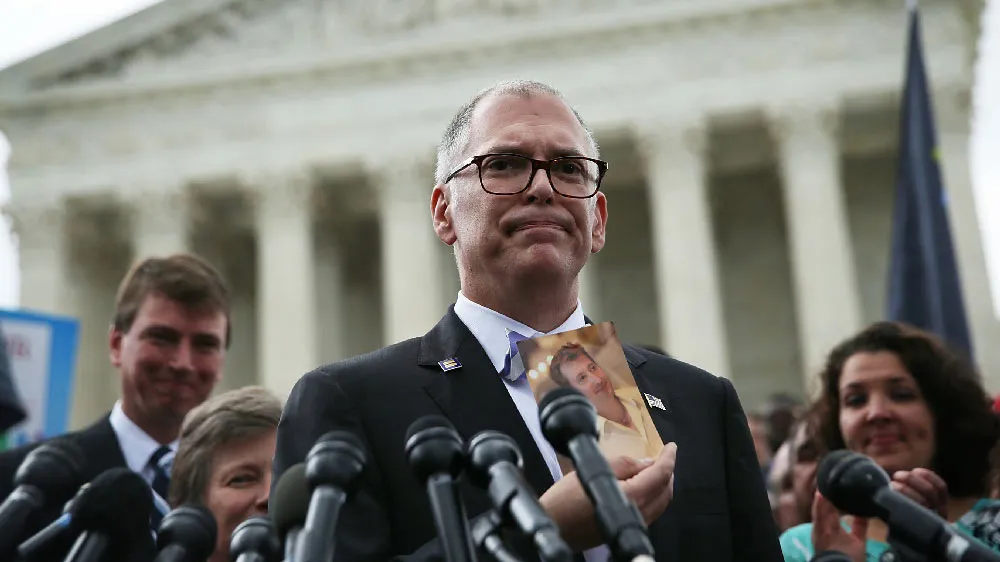November 15, 2012
'The Postcard Age' Debuts at Boston's Museum of Fine Arts
Kilian Melloy READ TIME: 10 MIN.
"Postcards like these are tiny slices of time," reads the text at the start of "The Postcard Age: Selections from the Leonard A. Lauder Collection,", an exhibit of 700 postcards drawn from an archive assembled by Est�e Lauder chairman emeritus and former CEO Leonard A. Lauder over the course of his lifetime.
"In the decades around 1900, postcards were Twitter, e-mail, Flickr, and Facebook, all wrapped into one," the Museum's press release on the exhibit notes. "A postcard craze swept the world, as billions of cards were bought and mailed, or just pasted into albums. Many famous artists turned to the new medium, but one of the great pleasures of postcards is how some of the most beautiful and interesting cards were made by artists whose names we barely know.
"This unprecedented exhibition traces how big historical and cultural themes of the modern age -- enthralling, exciting, and sometimes disturbing -- played out on the postcard's tiny canvas."
Mr. Lauder was present at the recent media event to introduce the exhibit.along with a number of individuals from the MFA staff. Lauder praised the MFA staff for the work they had done to sort through 100,000 postcards, select and group 700 individual examples, and group them in a way that allowed each set to "make one statement" and yet still "talk to each other."
"Once A Collector, Always A Collector."
Lauder was born in 1933 and grew up during the Great Depression. From early in his boyhood, he had a fascination with photojournalism and its power to take the far-distant and make it immediate, which, coupled with a love of art, defined his tastes. (Lauder is also a collector of paintings, especially canvases by cubist masters.)
"The only way to get photographs of what was really happening was through the itinerant postcard photographer, who went around photographing what was going on," Lauder recalled of those years in the early and mid 20th Century.
The postcards Lauder collected also allowed him to feed his loves of architecture and history. To see them now on display in a museum the caliber of Boston's MFA seems entirely fitting.
"These wonderful images that I've spend years trying to collect and put together, gathered in this way, look so beautiful," Lauder exclaimed.
Lauder exhorted the press not to make the story about him, but rather to focus on the postcards the museum's staff have grouped into sparkling little constellations.
Some of the cards are virgin; others have been written on, stamped, and mailed. Lauder professed an especial fondness for the cards that have been mailed, saying that the messages they convey offer intimate glimpses into the lives of the people who wrote them. Among his favorites is a postcard send by a young soldier fighting in World War I.
Lauder told EDGE that he continues to collect post cards even now. "Even though I am slowing down a bit, I can't resist. Once you are a collector, you are always a collector."
"By the way, I don't buy to possess," Lauder added. "I only buy something to add to what I think is already a very complete collection."
But "complete" is a relative term. Lauder went on to say, "The reason I love postcards is it's an open-ended challenge. If I had another thirty years, I would still keep on going."
Slices of Time and Life
Entering the Lois B. and Michael K. Torf Gallery, the exhibit's visitor begins a journey into the Postcard Craze, an itinerary that begins with Paris, circa 1900. The postcards here record street scenes, cafe patrons in formal, expectant poses.
One lot, titled "Store Fronts," focuses on the Paris retail scene: A wine shop, a flower shop, a hair salon, a "butter and egg" shop... A "blanchisserie?" (This turns out to be a laundry service, not, as one might have surmised, a negligee shop.)
Proprietors and employees post in front, looking a little stuffy but ready to serve. Clearly, the infancy of the photographic medium -- a record of light as historic document -- is, at this stage, at one with infancy of the postcard format.
The cards are grouped by theme. "Getting Around" collects images of horse drawn (and horseless) conveyances; "Butchers" -- you guessed it -- brings together a number of images (somewhat rarefied, one would imagine) of butchers' shops.
"The Market: Les Halles" presents vendors posing with their wares -- by the basket, box, and burlap bag full. "Streets and Boulevards" is packed with early views of motorized traffic, horses, pedestrians -- and a subway entrance. Oh, the wonders of this modern age!
"At Work" purports to record the daily labors of street sweepers, brewery workers, bakers... except, no one is really working. Everybody is standing to attention for the camera.
Postcards on Postcards
There are even postcards depicting the production of postcards! What's remarkable about this meta-treatment of the subject is that here, for the first time, no one seems to be posing. These glimpses of a new commercial art form seem to break through at last into the realm of the candid.
This more realistic, "slice-of-time" feel extends to highly unusual historical circumstances. "Paris Flooded, January 1910" shows Parisians rowing along the streets, walking makeshift plank sidewalks, or climbing up vehicles to stay out of the damp. So charming now, but no doubt a right pain back then.
There is a little leisure here, in a grouping titled "At the Races." Well dressed men and women, replete with top hats, walking sticks, feathered hats, and other finery stroll and take in an afternoon's entertainment.
Indeed, the new format seems quickly to have become a playground for amusing imagery. The series: "A Travers Paris" ("Around Paris") comprises three cards from the first decade of the 20th Century. Each card offers a light-hearted sketch of couples from various social classes.
"Curiosities-Parisiennes," from 1905, is not just amusing; it's slightly risqu�! Also a little bit naughty are the "Photomontages of NYSE women on neckties," two cards from 1911.
But wherever an artistic message can be conveyed is also a space for commerce. "Continental Pneumatic" is a set of 4 color lithographs produced in Germany.
Here and About
More directly commercial are the cards in the "About Town" section. The going concerns and must-see attractions of the day: Trocadero in Hamburg, and a roller skating rink that serves "5 o'clock teas" boasting "Exquisite Cakes." (Both 1910)
The "Grand Cafe" 'in Sch�nberg (1914). Basel's Zoological Garden (a set of three postcards, circa 1922). Coney Island -- in a series of "hold to light" cards that are exquisite when illuminated from behind, tiny bulbs and details coming alive with color.
Post cards served as little billboards, as with examples that are essentially ads for Michelin tires (1910), Falstaff beer (1909), Talmone Chocolate (1901), and other goods: Cheeses, vermouth, Campari, furs....
Those commercial messages inevitably become entangled with social messages, not all of them flattering. The exhibit includes a section of postcards devoted to the theme of "Women," and what a revelation it is to see how the (presumably male) artists viewed the fairer sex: Sometimes, as it turns out, not so fair. Some of the postcards depict women wearing muzzles and women with chimp-like faces.
Cheek by jowl with these odd images are the now-standard idealizations of the feminine form: Women modeling hats. Women dressed for the road. Women showing off their legs from beneath layers and layers of skirt, in the three cards of the "Bal du Moulin Rouge" series from 1905. ("Every night at 9 o'clock," the slogans promise.)
Je me souviens
The postcard as souvenir comes to the fore with a small selection of marvelous hold-to-light cards celebrating the 1900 "Universal Exposition." Other UE cards depict fabulous architecture, including the Universal Exhibition's most enduring work, the Eiffel Tower.
Indeed, the collection includes two identical Eiffel Tower cards, one virgin and one bearing a scrawled account, in elegant old-school penmanship, of being at the top of the 900-meter structure. It was from that vantage that the author, a V. Meyret, sent "my best kisses to my lovely Rosa, and my pretty Renee and my dear little Rapha�l". The card's message was written in 1889, the year the Eiffel Tower opened.
Postcard Politics
Postcard politics offered pithy commentary on world affairs, like bumper stickers you could dispatch through the mail. This was particularly true as war swept the globe. "Our Heroes" is a set of Parisian lithographs that depicts soldiers in the field. For the more specifically minded, a set of six cards commemorates a series of battles between Germany & France, 1914; the cards show Parisian and German forces as they move back and forth across the same map.
The other side had its postcards, too: One card sports an illustration of the German army on the move, flags aloft. "With United Forces!" the slogan declares.
Home Fires
But even the clouds of war could not entirely shroud glimmers of a bright future.
Depictions of athletic events abound. The 1913 Hannover Sports Festival, is commemorated with cards printed in Magdeburg, Germany, that stylize images of tennis, polo, and rugby.
The 1924 Olympics in Paris spawned postcards that boasted depictions of wrestling, boxing, javelin, and crewing. Similarly, the 1936 Olympics in Germany gave rise to postcards celebrating sports such as fencing, boxing... and, oh dear, an Art Deco Aryan who has sprouted wings in an advert for Lufthansa.
Even as some designs caricatured well-known figures as buzzards and bats, and an artist known as "Geo" riffed on "Heads of State," other postcards celebrated the mechanical advances of the era -- especially aviation. Planes! Zeppelins! Not to mention ground transportation such as cars and motorcycles.
Where could a man go with such rapid new modes of travel? Why -- all over! Postcards for Cairo, Cuba, and Monte-Carlo tempt the eye and the feet; these artifacts are both tourism ads and ready-made notices of worldly sophistication, perfect for arousing the envy of friends back home.
And speaking of home and home fires, another group of postcards shows us what the times proffered the ladies... home appliances! It was truly a different time, and these bright little notices, like pixels on a video screen of today, collectively resolve an image -- crude, perhaps, and easy to gloss with nostalgia -- of a rich and tumultuous era.
A stroll through this dazzling collection feels, at the end, like a letter from the past itself -- and an inquiry: What marvels, controversies, and indelible images will we have to offer in our turn?
"The Postcard Age: Selections from the Leonard A. Lauder Collection" continues at the Museum of Fine Arts, Boston, through April 14, 2013.
Museum of Fine Arts, Boston, Avenue of the Arts, 465 Huntington Avenue, Boston, Massachusetts, 02115
Kilian Melloy serves as EDGE Media Network's Associate Arts Editor and Staff Contributor. His professional memberships include the National Lesbian & Gay Journalists Association, the Boston Online Film Critics Association, The Gay and Lesbian Entertainment Critics Association, and the Boston Theater Critics Association's Elliot Norton Awards Committee.





